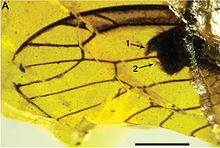Styporaphidia? hispanica
|
Styporaphidia Temporal range: Aalenian–Albian |
|
|---|---|
 |
|
| S.? hispanica holotype | |
| Scientific classification | |
| Kingdom: | Animalia |
| Phylum: | Arthropoda |
| Class: | Insecta |
| Order: | Raphidioptera |
| Family: | †Mesoraphidiidae |
| Genus: |
Styporaphidia Engel & Ren, 2008 |
| Species | |
|
|
Styporaphidia is a genus of snakefly, belonging to the extinct family Mesoraphidiidae, containing up to two species, the type species Styporaphidia magia and tentatively Styporaphidia? hispanica. The genus was named from the Greek stypos meaning "stem" or "stump" and Raphidia, the type genus for, and most often used as, a stem for generic names in the order Raphidioptera. The species name of S. magia is from the Greek word mageia meaning "magic" while the species name for S.? hispanica is from the Latin Hispania meaning "Spain" in reference to the type locality of the species.
S. magia is known from only the holotype, a single specimen of undetermined sex, deposited in the Department of Biology, Capital Normal University, Beijing, China as specimen number NNS-200202. Preserved as a compression fossil, the individual is fossilized in a resting position giving a top view to the body and wings. Paleontologiests Michael S. Engel and Dong Ren first studied and described S. magia and the co-occurring Ororaphidia and in 2008, publishing the type description in the Journal of the Kansas Entomological Society volume 81. The S. magia holotype was found in the near Daohugou Village, Inner Mongolia, China in strata belonging to the Jiulongshan Formation. This formation is dated to the early middle Jurassic and specifically Aalenian to Bajocian in age. The dating places S. magia and Ororaphidia as the oldest raphidiopterans known from China to date.
...
Wikipedia
